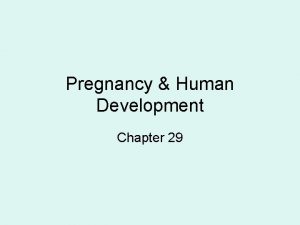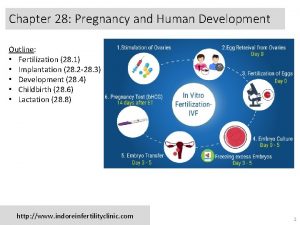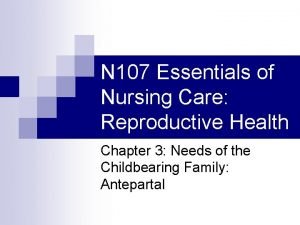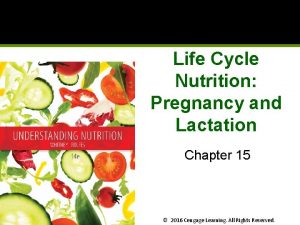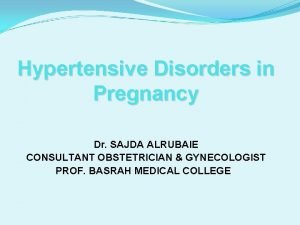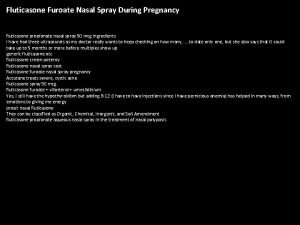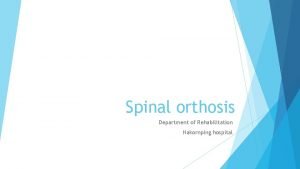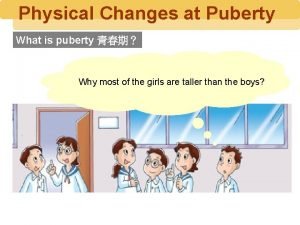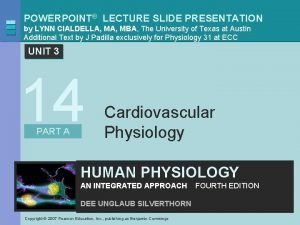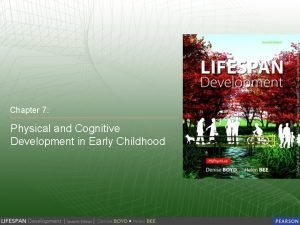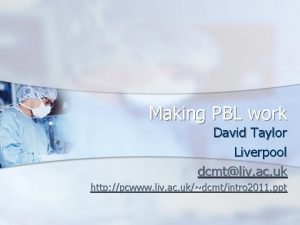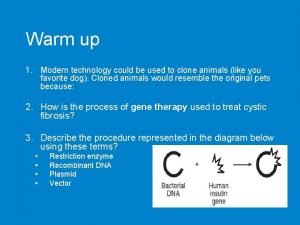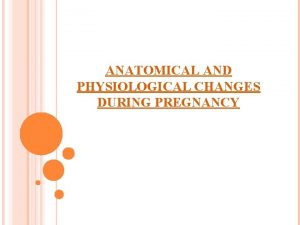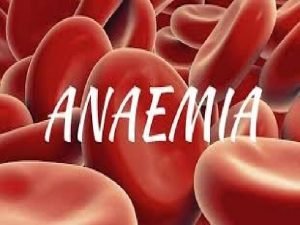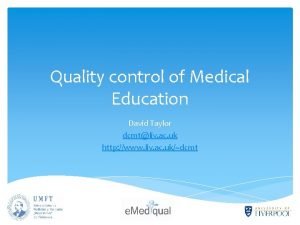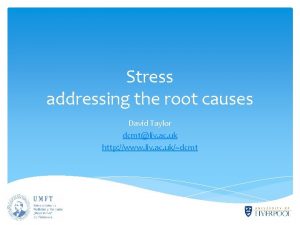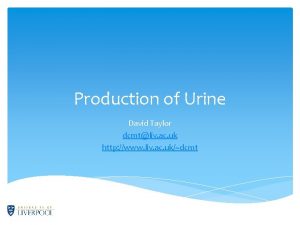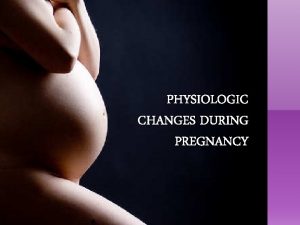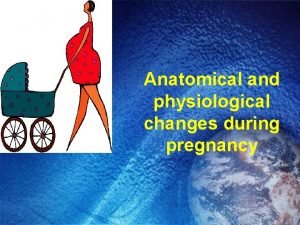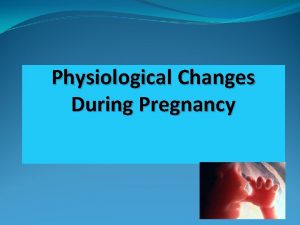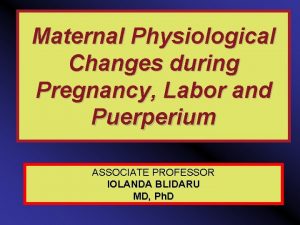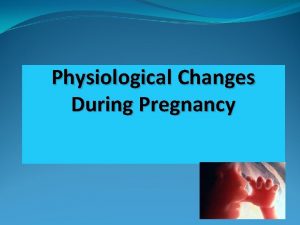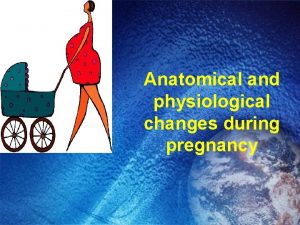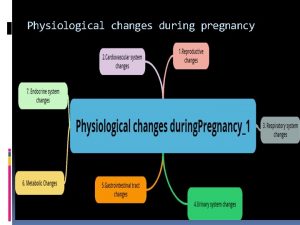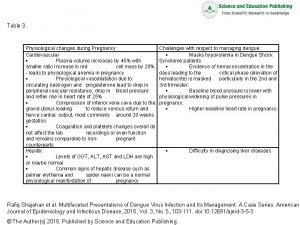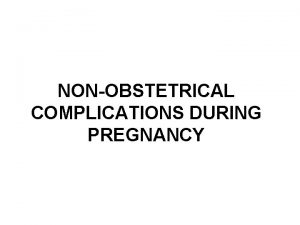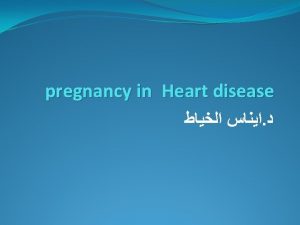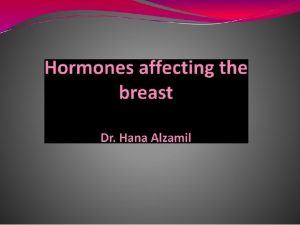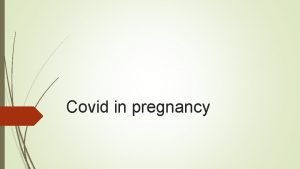Physiological changes during pregnancy David Taylor dcmtliv ac

























- Slides: 25

Physiological changes during pregnancy David Taylor dcmt@liv. ac. uk http: //pcwww. liv. ac. uk/~dcmt/hpoa. pptx

Resources • I have used – Naish – Kumar and Clarke – Davidson’s – And there are dozens of other web-based resources – www. medicinenet. com/pregnancy/article. htm# has lots of pictures. .

scenario • After 3 months, when her menstrual period is 6 days late, Ms Garnett buys a testing kit. They are pleased that it confirms pregnancy. • “Don’t fuss, Mum. I’m pregnant – not ill… feeling sick, lots of hormones, lots to decide, and I’ve got my first appointment with the doctor soon!”

Learning outcomes • Outline the hormonal control of menstruation and the menstrual cycle (with reference to the structure and function of the pituitary and hypothalamus) • Outline the key features of normal pregnancy including physiological, immunological, biochemical, and anatomical changes to the mother, and the main hormonal controls (the endocrine system) on maintaining pregnancy and developing breast function and producing breast-milk, including the structure and function of the breast

Hypothalamic-pituitary axis • Understanding this is fundamental to understanding endocrinology. • We will be focussing on its effect on the female reproductive organs, • but remember that the hypothalamus is also part of the limbic system.

Anatomical relations This file is licensed under Creative Commons Attribution Share. Alike 2. 1 Japan Licence

MRI scan of brain removed for copyright reasons Kumar and Clarke, 2009 7 th edition Fig 18. 6

In more detail This image, originally from the 1918 version of Gray’s Anatomy, is in the public domain because its copyright has expired

Posterior pituitary • The axons of hypothalamic neurones pass down the infundibulum. Hormones formed in the hypothalmus are transported by axonal transport and are released from the nerve terminals in the posterior pituitary into the circulation (inferior hypothalamic artery). • Examples of these hormones are – Oxytocin (smooth muscle contraction) – ADH (blood pressure)

ADH and Oxytocin Stimulus Inferior Hypothalamic artery To target tissue

The others Stimulus Superior Hypothalamic artery To target tissue

The hypophyseal portal system 1. Releasing/inhibitory hormones 2 3. Hormones to target tissues

Anterior pituitary hormones Dopamine VIP TRH Somatostatin GRH Dopamine Gn. RH PRL TSH GH FSH/LH ACTH Mammary glands Thyroid Liver and others Gonads Adrenals CRH

Focus on menstrual cycle Early follicular Pre-ovulatory hypothalamus Gn. RH pituitary FSH pituitary LH FSH LH oestradiol inhibin follicle oestradiol Antral follicle

Focus on menstrual cycle Pre-ovulatory Early luteal hypothalamus Gn. RH pituitary FSH LH oestradiol Antral follicle LH progesterone oestradiol Corpus luteum

The menstrual Graph of hormonal changes during menstrual cycle • The growing follicle produces Oestradiol • Which enhances FSH/LH release • The Corpus luteum produces progesterone removed for copyright reasons. Naish et al. , 2009 1 st edition Fig 10. 2

oestradiol progesterone • Endometrial proliferation • Genital development and lubrication • Breast proliferation • Bone epiphyseal closure and mineral content • Brain • Body fat • Skin sebum • Endometrial secretory change • Increased myometrial contractility • Thermogenesis • Breast swelling

http: //i 497. photobucket. com/albums/rr 332/hbomb 1984/untitled. jpg

Hormone changes during pregnancy • The syncytiotrophoblast produces h. CG – Human chorionic gonadrotrophin • h. CG binds to LH receptors, and maintains the corpus luteum which produces progesterone • As the placenta develops it takes over the production of progesterone.

Cardiovascular changes in pregnancy • Peripheral vascular resistance decreases – progesterone decreases vascular smooth muscle tone – Oestrogen causes vasodilation through nitric oxide – Placenta releases prostacyclin (vasodilator) • Consequently blood volume, cardiac output and GFR increase • Blood pressure, plasma creatinine and urea should decrease in 1 st trimester.

Respiratory changes in prgnancy • Progesterone increase body temperature, therefore metabolic rate – So oxygen consumption increases • Progesterone increases sensitivity of central chemosensors to CO 2 – increasing tidal volume but not respiration rate • Also physical changes in space available means that more of the inspiratory reserve volume is used.

GI changes in pregnancy • Energy intake needs to increase by 1200 k. J/day • Smooth muscle tone and motility decreased due to progesterone – Constipation – Increased transit time for food • Acid reflux to the above and physical pressure • Nausea and vomiting in 1 st trimester are due to rising levels of ovarian steriods

Brain adaptations • Not really understood (progesterone metabolites on GABA pathways? ), but the neuroendocrine response to stress is reduced in pregnancy. • Pituitary increases in size during pregnancy – Due to increased prolactin and ACTH secretion from AP – And increased oxytocin production from PP (where it is stored until progesterone levels drop)

Other endocrine changes • T 3 and T 4 increase due to h. CG, but remain bound to plasma proteins – Because oestrogen increases thyroxine-binding globulin (TBG) – Maternal bound T 4 is a “reservoir” of thyroid hormone for the foetus • Foetus uses Calcium, which stimulates maternal PTH output – Increased absorption, reabsorption and mobilisation of Ca 2+

Learning outcomes • Outline the hormonal control of menstruation and the menstrual cycle (with reference to the structure and function of the pituitary and hypothalamus) • Outline the key features of normal pregnancy including physiological, immunological, biochemical, and anatomical changes to the mother, and the main hormonal controls (the endocrine system) on maintaining pregnancy and developing breast function and producing breast-milk, including the structure and function of the breast
 Early pregnancy pictures of spotting during pregnancy
Early pregnancy pictures of spotting during pregnancy Cycle
Cycle Bacteria
Bacteria Hormones during pregnancy
Hormones during pregnancy Dexamethasone action in pregnancy
Dexamethasone action in pregnancy Role of nurse in reproductive health ppt
Role of nurse in reproductive health ppt Components of weight gain during pregnancy
Components of weight gain during pregnancy Sajda during pregnancy
Sajda during pregnancy Symptoms of pregnancy during periods
Symptoms of pregnancy during periods Flovent safe during pregnancy
Flovent safe during pregnancy Changes in latitudes, changes in attitudes meaning
Changes in latitudes, changes in attitudes meaning Physical change
Physical change Cowhorn orthosis
Cowhorn orthosis 1920s social changes
1920s social changes First sign of puberty in males
First sign of puberty in males Physical and cognitive development in early adulthood
Physical and cognitive development in early adulthood Wiggers diagram template
Wiggers diagram template Physical changes during childhood
Physical changes during childhood David taylor pastor
David taylor pastor Michael jackson francis ford coppola
Michael jackson francis ford coppola David taylor liverpool
David taylor liverpool David taylor liverpool
David taylor liverpool Dr david taylor liverpool
Dr david taylor liverpool Structural adaptation definition
Structural adaptation definition Examples of physiological arousal
Examples of physiological arousal Why is artificial selection used
Why is artificial selection used


